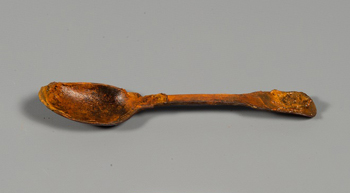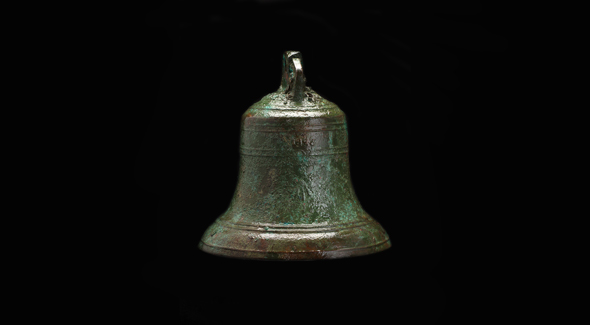
2018 Artifacts
Wrecks of HMS Erebus and HMS Terror National Historic Site
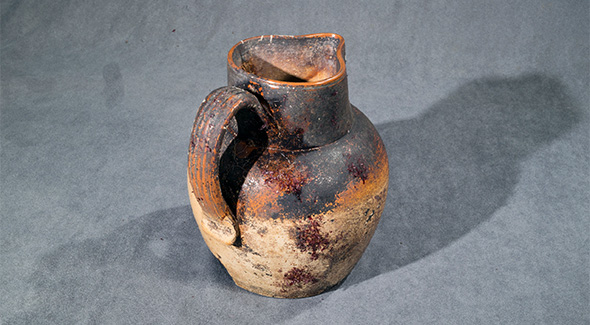
Recovered from HMS Erebus, on lower deck
September 2018
Pitcher

-
Where was this artifact found?
It was discovered on the lower deck, in one of the officers’ cabins.
-
What material is this artifact made of?
The pitcher is likely made of English brown salt glaze stoneware.
-
What was this artifact used for?
This pitcher could have been used for pouring liquids, such as water.
-
What do we know about this artifact?
It was discovered inside a collapsed piece of fitted furniture, next to a pile of small plates (not recovered).
Pitcher
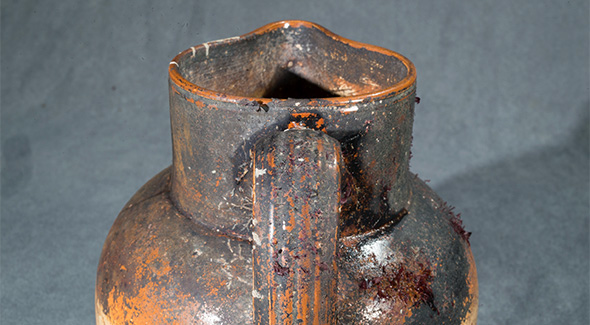
-
Where was this artifact found?
It was discovered on the lower deck, in one of the officers’ cabins.
-
What material is this artifact made of?
The pitcher is likely made of English brown salt glaze stoneware.
-
What was this artifact used for?
This pitcher could have been used for pouring liquids, such as water.
-
What do we know about this artifact?
It was discovered inside a collapsed piece of fitted furniture, next to a pile of small plates (not recovered).

1 of 3 recovered from HMS Erebus, on upper deck
September 2018
Block sheave

-
Where was this artifact found?
This sheave or wheel was found on the fore, starboard side of the upper deck.
-
What material is this artifact made of?
It appears to be made of copper alloy, probably bronze.
-
What was this artifact used for?
Sheaves like this one were part of the numerous wooden and metal pulley blocks used in running rigging.
-
What do we know about this artifact?
It is marked with a broad arrow.
Block sheave
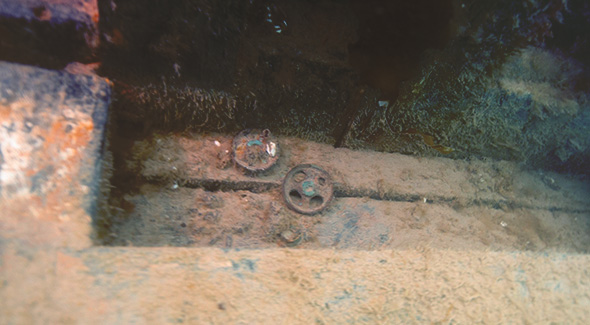
-
Where was this artifact found?
This sheave or wheel was found on the fore, starboard side of the upper deck.
-
What material is this artifact made of?
It appears to be made of copper alloy, probably bronze.
-
What was this artifact used for?
Sheaves like this one were part of the numerous wooden and metal pulley blocks used in running rigging.
-
What do we know about this artifact?
It is marked with a broad arrow.
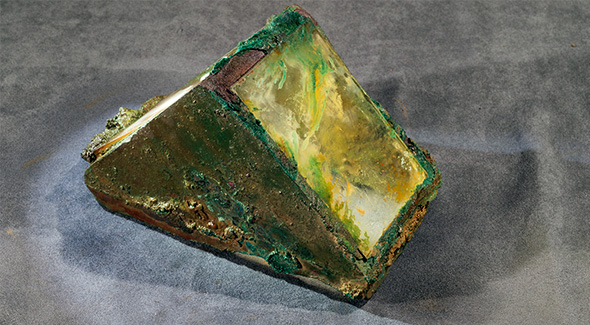
Recovered from HMS Erebus, on lower deck
September 2018
Artificial horizon roof

-
Where was this artifact found?
The object was discovered on the lower deck in an officer’s cabin.
-
What material is this artifact made of?
The copper alloy frame is fitted with two colourless glass panes.
-
What was this artifact used for?
This instrument was used in conjunction with a sextant to determine latitude when the horizon was hidden, for example by ridges of sea ice.
-
What do we know about this artifact?
The roof usually goes over a tray in which mercury would be poured, and acts as a mirror.
Artificial horizon roof
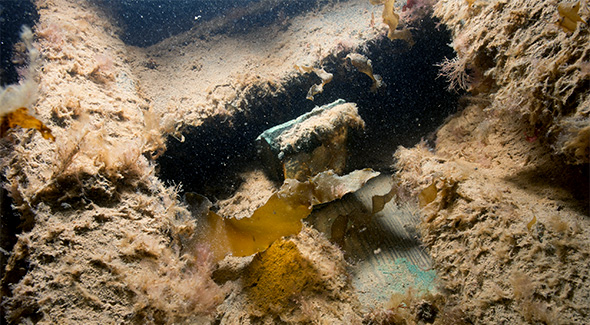
-
Where was this artifact found?
The object was discovered on the lower deck in an officer’s cabin.
-
What material is this artifact made of?
The copper alloy frame is fitted with two colourless glass panes.
-
What was this artifact used for?
This instrument was used in conjunction with a sextant to determine latitude when the horizon was hidden, for example by ridges of sea ice.
-
What do we know about this artifact?
The roof usually goes over a tray in which mercury would be poured, and acts as a mirror.

Recovered from HMS Erebus, on upper deck
September 2018
Nail

-
Where was this artifact found?
It was found on one of the upper deck beams.
-
What material is this artifact made of?
This small copper alloy forged nail has a square shank and a square flat head.
-
What was this artifact used for?
It was probably used to hold layers of upper deck planking together.
-
What do we know about this artifact?
It is marked with a broad arrow.
Nail
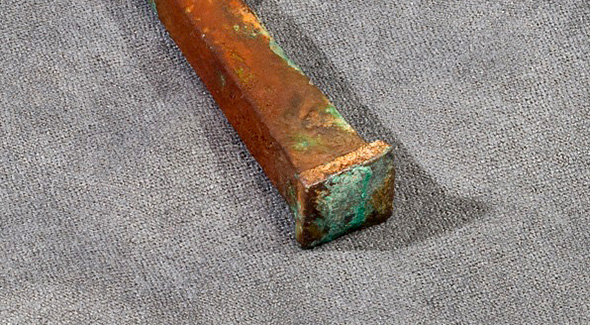
-
Where was this artifact found?
It was found on one of the upper deck beams.
-
What material is this artifact made of?
This small copper alloy forged nail has a square shank and a square flat head.
-
What was this artifact used for?
It was probably used to hold layers of upper deck planking together.
-
What do we know about this artifact?
It is marked with a broad arrow.
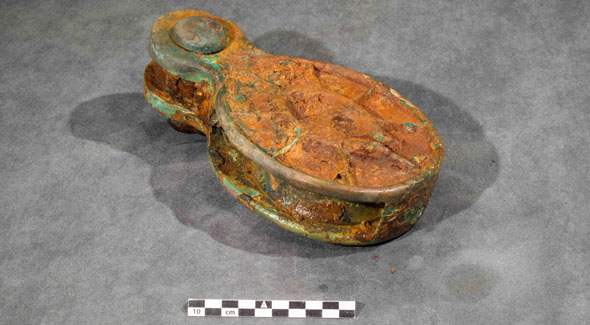
Recovered from HMS Erebus, on upper deck
September 2018
Block with shackle

-
Where was this artifact found?
This high-quality block fitted with an integrated shackle and split pin was found on the upper deck.
-
What material is this artifact made of?
It appears to be made of copper alloy, probably bronze.
-
What was this artifact used for?
This block would have been used for the running rigging of the vessel.
-
What do we know about this artifact?
Inscriptions that are not completely legible - possibly “6⅓” and “C[PR]N” - would refer to the regulation size of the block in inches, and its maker.
Block with shackle
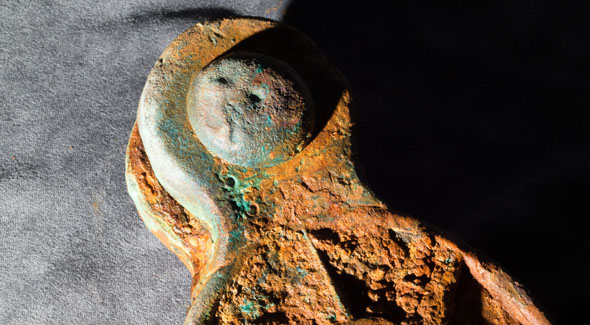
-
Where was this artifact found?
This high-quality block fitted with an integrated shackle and split pin was found on the upper deck.
-
What material is this artifact made of?
It appears to be made of copper alloy, probably bronze.
-
What was this artifact used for?
This block would have been used for the running rigging of the vessel.
-
What do we know about this artifact?
Inscriptions that are not completely legible - possibly “6⅓” and “C[PR]N” - would refer to the regulation size of the block in inches, and its maker.

Recovered from HMS Erebus, on upper deck
September 2018
Fearnought

-
Where was this artifact found?
It was found in between layers of upper deck planking.
-
What material is this artifact made of?
It is probably wool felt with tar.
-
What was this artifact used for?
This type of (tarred) felt was used to waterproof the upper deck.
-
What do we know about this artifact?
Impressions of upper deck planks seams and butt ends, as well as nails are visible on the sample.
Fearnought

-
Where was this artifact found?
It was found in between layers of upper deck planking.
-
What material is this artifact made of?
It is probably wool felt with tar.
-
What was this artifact used for?
This type of (tarred) felt was used to waterproof the upper deck.
-
What do we know about this artifact?
Impressions of upper deck planks seams and butt ends, as well as nails are visible on the sample.
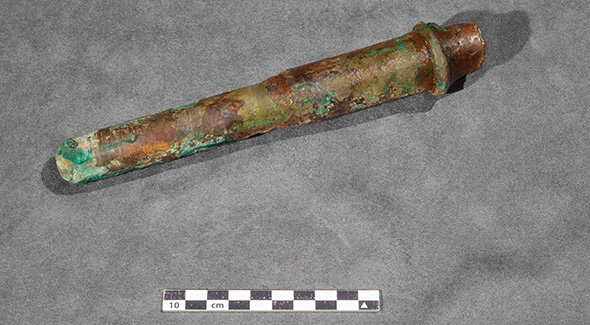
Recovered from HMS Erebus, on upper deck
April 2015 and September 2018
Belaying pin

-
Where was this artifact found?
This belaying pin was recovered from HMS Erebus in 2018. Several more belaying pins made of solid bronze were also recovered from the upper deck on the port side in earlier missions.
-
What material is this artifact made of?
Approximately 30 cm long, the belaying pins have smooth, rounded handles that are the size of the palm of a hand. Two of them are damaged and one is entirely broken. The damage may have been caused when the ship’s rigging collapsed, while HMS Erebus was sinking or after it had sunk.
-
What was this artifact used for?
Belaying pins were used to tie the various ropes of the rigging, such as those used to control the sails.
-
What do we know about this artifact?
Most belaying pins are made of wood. The use of bronze, a more costly and resistant material, is an indication of the quality of the equipment used for the Franklin expedition.
Belaying pin
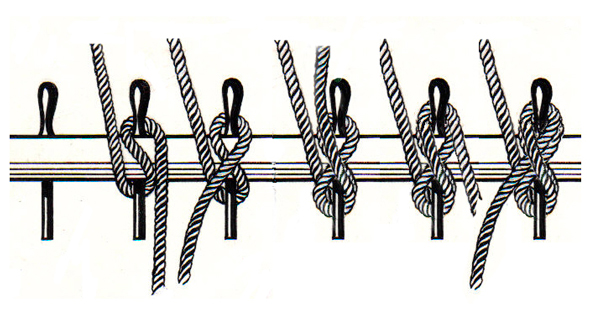
-
Where was this artifact found?
This belaying pin was recovered from HMS Erebus in 2018. Several more belaying pins made of solid bronze were also recovered from the upper deck on the port side in earlier missions.
-
What material is this artifact made of?
Approximately 30 cm long, the belaying pins have smooth, rounded handles that are the size of the palm of a hand. Two of them are damaged and one is entirely broken. The damage may have been caused when the ship’s rigging collapsed, while HMS Erebus was sinking or after it had sunk.
-
What was this artifact used for?
Belaying pins were used to tie the various ropes of the rigging, such as those used to control the sails.
-
What do we know about this artifact?
Most belaying pins are made of wood. The use of bronze, a more costly and resistant material, is an indication of the quality of the equipment used for the Franklin expedition.
Other galleries
- Date modified :
